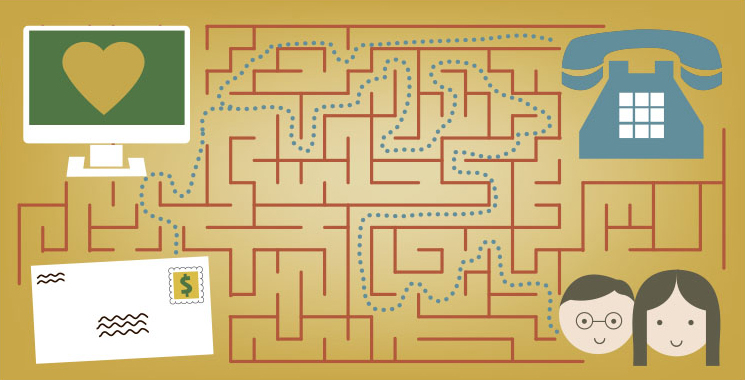Keeping Cross-channel Communications Consistent
September 08, 2014 - by Lesley Hostetter

Today’s donors are active across multiple channels — and they’re increasingly going online and sharing on social. It’s difficult for non-profits to know how to chart a clear path for their donors when donors are constantly going off on detours.
Though we can’t control how or when donors give — we can control the message they receive. With clear internal communication and sufficient planning, creating consistent messaging doesn’t have to be difficult.
Here are some tips to guide you:
1. Create a communications calendar — and use it. We often see organizations go to the trouble of creating a consolidated communications calendar, but then ignore it. Donors appreciate hearing from you throughout the year on a variety of topics that all flow nicely from one to another. Be sure to update your calendar throughout the year — campaigns will always be in flux at planning time, so finalize the details as you go.
- Bonus tip: Add segmentation to your calendar. This will help you see exactly what messages different donor groups will receive. (And sometimes you’ll identify a weak spot – often high-dollar donors or sustainers aren’t hearing from you often enough!)
2. Rally the troops. Get everyone you work with on the same page. This means your internal teams and external teams (agencies, vendor partners). Discuss the details well in advance of each big campaign. Make sure the message and the audience are aligned to support the overall campaign objectives.
3. Mixing it up is okay. When controlling the message across channels, there’s no need to use the same exact language in all media. Your campaign should cross channels (because your donors do), but the content and strategy need to be adapted for each medium. Keep the campaign name and purpose uniform — but tailor the creative to each channel. It’s critical to consider what will enhance the donor’s overall experience.
- Bonus tip: Each channel has pros and cons, so when planning a multi-channel fundraising effort, carefully consider the channel mix from the start. Before the campaign launches, set key performance indicators for each channel to understand the goals and monitor results.
4. Appoint a gatekeeper. It’s imperative that one person within the organization’s fundraising department have full authority over all fundraising messages in all channels. We’ve all seen watered-down copy, or an email campaign that doesn’t really sound like the mailing it accompanies. Results will improve if one person is tasked with syncing messages.
- Bonus tip: This is something that smaller organizations often do better than large organizations. With a smaller staff, fundraising across all channels typically lies with one or two people. Fewer cooks in the kitchen typically results in clearer, more compelling multi-channel campaigns.
Implementing multi-channel campaigns can definitely be challenging. But it’s a challenge we’re up for — and hope you are, too! After all, it’s the solution to improving donor retention and raising more money.
ENEWS SIGNUP
If you enjoyed this article and would like to be alerted when the next one is published, please enter your email address.
Enews Articles
October 2022
Engaging Networks Community Conference 2022
August 2022
April 2022
Build a Successful, Data-driven Digital Fundraising Program Through Testing!
February 2022
Is It Time for A Fundraising Reboot?
January 2022
New Year Brings Hope for the Future
May 2021
November 2020
Are You Ready for Giving Tuesday?
August 2020
Waxing Philosophical About Email Deliverability
August 2020
How to Retain your COVID Emergency Donors
July 2020
How to Ride the Wave and Raise Money During the 2020 Elections
July 2020
Telling Your Donors You Care in the Time of COVID (while still asking for a gift)!
June 2020
The Best $49 You’ll Spend All Year
May 2018
May 2018
4 Things You Should Know About 2017 Giving
March 2018
Navigating the Unknown Impact of New Tax Laws
August 2017
Case Study: Using SMS to Get Donations at Year-End
May 2017
February 2017
What (and Who) We Should Be Asking About State Laws
January 2017
2016 Digital Year-End: An Inbox Audit
September 2016
December 2015
October 2015
The Great Pumpkin and the Myth of the Unsolicited Donation
July 2015
July 2015
June 2015
Lady Gaga and the Importance of Relationships
May 2015
Back to the (Digital) Drawing Board
February 2015
Understanding Donors — The Old Fashioned Way
January 2015
My Four Fundraising Resolutions for 2015
November 2014
The Importance of Being Earnest
October 2014
AMMC Conference Teaches This Old Dog New Tricks
October 2014
Too Hot to Handle … How to Turn Warm Prospects into Donors
August 2014
5 Tips for Better Fundraising Copy
June 2014
Keep Boredom out of the Boardroom
May 2014
April 2014
How to Raise Money from Baby Boomers
February 2014
Five Take Aways from the February DMA-NF Conference
January 2014
What Kind of Friend are You? Building Relationships That Last
December 2013
#GivingTuesday – Worth the Fuss?
November 2013
October 2013
1,500,050 Charities Making a Difference — A Statistic Donors Need To See
October 2013
The USPS Proposed Rate Hike — What Does It All Mean?
June 2013
Investing in Acquisition: How to Get Your Board on Board
May 2013
May 2013



